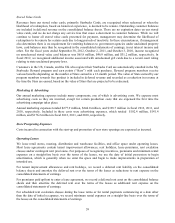Starbucks 2012 Annual Report Download - page 74
Download and view the complete annual report
Please find page 74 of the 2012 Starbucks annual report below. You can navigate through the pages in the report by either clicking on the pages listed below, or by using the keyword search tool below to find specific information within the annual report.68
Level 2: For corporate and agency bonds, for which a quoted market price is not available for identical assets, we
determine fair value based upon the quoted market price of similar assets or the present value of expected future
cash flows, calculated by applying revenue multiples to estimate future operating results and using discount rates
appropriate for the duration and the risks involved. Fair values for commercial paper are estimated using a
discounted cash flow calculation that applies current imputed interest rates of similar securities. Fair values for
certificates of deposit are estimated using a discounted cash flow calculation that applies current interest rates to
aggregate expected maturities.
Level 3: We determine fair value of our ARS using an internally developed valuation model, using inputs that
include interest rate curves, credit and liquidity spreads, and effective maturity.
Proceeds from sales of available-for-sale securities were $5.0 million, $0.0 million, and $1.1 million in fiscal
years 2012, 2011, and 2010, respectively. For fiscal years 2012, 2011, and 2010 realized gains and losses on sales
and maturities were not material.
Certificates of deposit have maturity dates ranging from approximately one month to 2 years and principal
amounts, that when aggregated with interest that will accrue over the investment term, will not exceed Federal
Deposit Insurance Corporation limits. Certificates of deposit with original maturities of 90 days or less are
included in cash and cash equivalents. The amounts invested in certificate of deposits that were included in cash
and cash equivalents were $0.2 million and $4.2 million as of September 30, 2012 and October 2, 2011,
respectively.
Long-term investments (except for ARS) generally mature within 3 years. ARS have long-dated maturities but
provide liquidity through a Dutch auction process that resets the applicable interest rate at pre-determined calendar
intervals. Our ARS are collateralized by portfolios of student loans, substantially all of which are guaranteed by
the United States Department of Education. Due to the auction failures that began in 2008, these securities became
illiquid and were classified as long-term investments. The investment principal associated with the failed auctions
will not be accessible until:
• successful auctions resume;
• an active secondary market for these securities develops;
• the issuers replace these securities with another form of financing; or
• final payments are made according to the contractual maturities of the debt issues which range from 18 to
32 years.
We do not intend to sell the ARS, nor is it likely we will be required to sell the ARS before their anticipated
recovery, which may be at maturity.
Trading Securities
Trading securities include equity mutual funds and exchange-traded funds. For these securities, we use quoted
prices in active markets for identical assets to determine fair value, thus these securities are considered Level 1
instruments. Our trading securities portfolio approximates a portion of the liability under the Management
Deferred Compensation Plan (“MDCP”), a defined contribution plan. The corresponding deferred compensation
liability of $94.8 million and $84.7 million as of September 30, 2012 and October 2, 2011, respectively, is
included in accrued compensation and related costs on the consolidated balance sheets. The changes in net
unrealized holding gains/losses in the trading portfolio included in earnings for fiscal years 2012 , 2011 and 2010
were a net gain of $10.9 million, a net loss of $2.1 million, and a net gain of $4.1 million, respectively.
Derivative Assets and Liabilities
Derivative assets and liabilities include foreign currency forward contracts, commodity swaps and futures
contracts. Where applicable, we use quoted prices in active markets for identical derivative assets and liabilities
that are traded on exchanges. Derivative assets and liabilities included in Level 2 are over-the-counter currency
forward contracts and commodity swaps whose fair values are estimated using industry-standard valuation
models. Such models project future cash flows and discount the future amounts to a present value using market-
























